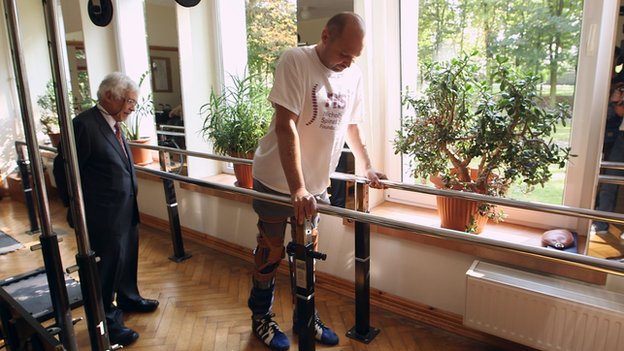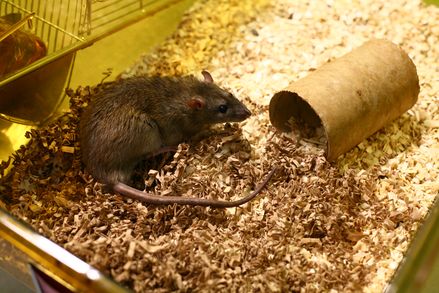Today, almost 30 years after Prof. Geoffrey Raisman first identified their potential to repair nerve damage in mice, the BBC reports that olfactory ensheathing cell transplantation has been successfully used to enable Darek Fidyka, who was paralyzed from the chest down in a knife attack in 2010, to walk again.
The paper reporting the transplant, which was carried out by surgeons in Poland and led by Geoffrey Raisman of the UCL Institute of Neurology, is published today in the journal Cell Transplantation (5). The technique involves taking specialized cells known as olfactory ensheathing cells (OECs) from the patient’s own patient’s olfactory bulbs, and then grafting these cells at the site of injury, where they promote nerve cell growth to bridge the gap and restore function. An added advantage in using the patient’s own cells is that it avoids the problem of rejection by their immune system.
Speaking earlier today Geoffrey Raisman described the results as “more impressive than man walking on the moon”. He’s not to far wrong, this achievement shows what is possible for regenerative medicine, and is the result of decades of basic and translational research. Indeed, whereas only 12 people have walked on the moon, this new technique has the potential to help many thousands of people to walk again here on earth.
2014 has been an extraordinary year of progress restoring function after spinal injury, in May we saw how epidural stimulation allowed 4 paralyzed men in the US to move their legs again, while scientists at Newcastle University in the UK used closed loop electrostimulation to restore voluntary movement in temporarily paralyzed monkey arms. These techniques, and now OEC transplantation, show that many cases of paralysis are potentially reversible. Not every technique will be appropriate for every patient, and it will take much additional research before they are widely available, but together they represent a huge advance.

In each case it is an advance that rests on many decades of careful research in both animals and in human subjects, in particular basic research that uncovered the role of specialized cells and provided scientists with the knowledge about organization and function of the brain and spinal cord that enabled these pioneering therapies to be developed.
In a post in 2012 I discussed how Geoffery Raisman’s research led to the successful testing of olfactory ensheathing cells in injured dogs, and I’m reposting that article here:
Paralysed dogs walk again thanks to nasal cell transplants…and Professor Raisman’s rats. (published 19 November 2012)
This morning the BBC News carried a report on a medical breakthrough – and it is not a term I use lightly – that has enormous implications for people who have been paralyzed following spinal cord injuries. A team at the University of Cambridge led by Professor Robin Franklin Department of Veterinary Medicine, along with colleagues at the MRC Centre for Regenerative Medicine in Edinburgh succeeded in restoring the ability to walk with their hind legs to dogs which had been paralyzed by spinal injury. To do this they removed a special type of cell called the olfactory ensheathing cell (OEC) from the nasal passageways of the dogs, grown them in culture until a sufficient number had been produced, and then transplanted them at the site of injury. Many of the dogs which received the transplant were subsequently able to walk with their hind legs if supported by a harness, and some even able to walk without being supported by a harness, whereas dogs which received a control injection did not recover the ability to move their hind legs.
This is a major medical advance, and the first time that cell transplantation has been demonstrated to reverse paralysis in a real-life situation where the injury involves a combination of damage to the nerve fibre and to surrounding tissues, and there is a significant delay between injury and treatment, and while the therapy did not completely restore function it marks a very significant step towards a therapy that can be evaluated in a human clinical trial. It also of course is a very promising therapy for dogs that have suffered spinal injuries, for example after being hit by a car, and as such is an excellent example of the One Health concept which seeks a closer integration of human and veterinary medicine.
As with many breakthroughs this one did not happen overnight, indeed it is the result of decades of research. The story really begins in 1985 when Professor Geoffrey Raisman at University College London (for a good overview of his work see the UCL spinal Repair Group homepage) was studying the unique ability of nerve fibres in the olfactory system to grow and make the connections with central nervous system – an ability that other adult nerve cells lack and which is probably retained in the olfactory system due to the importance of preserving the ability to smell despite exposure of nerve cells in the nasal passages to toxins in the environment (a good sense of smell being crucial to survival for many mammalian species). He found that in a part of the brain termed the olfactory bulb of mice and rats a specific type of glial cell, cells that act to support and regulate the activity of the nerve cells along which nerve impulses travel , were responsible for creating the pathway along which the olfactory nerve fibres could regenerate (1).
Studies in rats were key to unlocking the potential of olfactory ensheathing cells in repairing spinal injuries. Image courtesy of Understanding Animal Research
This discovery suggested that if these specialized olfactory ensheathing cells (OECs) were transplanted at the site of spinal cord injury they might promote the growth of a bridge of nerve cells that would reconnect the severed pathway and restore function. In a series of experiments in rats Professor Raisman and colleagues demonstrated that OEC transplantation could repair a variety of different types of spinal cord injury, in order to restore function, for example to improve the ability to breath and climb following spinal cord injury (2) and to restore the ability of rat paws to grasp in order to climb following lesion of the spinal nerve that runs from the spinal cord down through the arm (3). Other scientists provided additional key information, for example scientists at the University of New South Wales in Australia demonstrated that OECs could be isolated from the nasal mucosa as well as from the olfactory bulb (4), and that these can also repair spinal cord injuries, an important step since obtaining OECs from the nasal mucosa is far more straightforward and safer than harvesting them from the brain. These discoveries, and the refinement of OEC transplant techniques over the past 2 decades by scientists such as Prof. Raisman, paved the way for the “real life” veterinary study reported today. A human clinical trial of this technique cannot be far off, though it is worth noting Prof. Raisman’s words of caution to the BBC concerning what has been achieved and what is still to be done:
“This is not a cure for spinal cord injury in humans – that could still be a long way off. But this is the most encouraging advance for some years and is a significant step on the road towards it…This procedure has enabled an injured dog to step with its hind legs, but the much harder range of higher functions lost in spinal cord injury – hand function, bladder function, temperature regulation, for example – are yet more complicated and still a long way away.”
In this respect it is worth noting the other approaches to repairing spinal cord injury, for example using other glial cell known as astrocytes and the use of electrical stimulation have produced promising outcomes in animal studies and early human clinical trials. Indeed, a clinical study of electrostimulation that we discussed last year reported “improved autonomic function in bladder, sexual and thermoregulatory activity that has been of substantial benefit to the patient”. In the future these different approaches may be combined to maximize the benefit to the patient, but it is still far too early to say which techniques will best complement each other. One thing we can be sure of is that turning these very promising technologies into effective treatments – perhaps even cures – for paralysis will require further research, both in the lab and in the clinic.
Paul Browne
1) Raisman G. “Specialized neuroglial arrangement may explain the capacity of vomeronasal axons to reinnervate central neurons.” Neuroscience. 1985 Jan;14(1):237-54. PubMed: 3974880
2) Li Y, Decherchi P, Raisman G. Transplantation of olfactory ensheathing cells into spinal cord lesions restores breathing and climbing.” J Neurosci. 2003 Feb 1;23(3):727-31. 12574399
3) Ibrahim AG, Kirkwood PA, Raisman G, Li Y. “Restoration of hand function in a rat model of repair of brachial plexus injury.” Brain. 2009 May;132(Pt 5):1268-76. Epub 2009 Mar 13. PMID: 19286693
4) Lu J, Féron F, Mackay-Sim A, Waite PM. “Olfactory ensheathing cells promote locomotor recovery after delayed transplantation into transected spinal cord.” Brain. 2002 Jan;125(Pt 1):14-21. PMID: 11834589
5) Tabakow P et al. “Functional regeneration of supraspinal connections in a patient with transected spinal cord following transplantation of bulbar olfactory ensheathing cells with peripheral nerve bridging” Cell Transplantation, published online 20 November 2014 http://www.ingentaconnect.com/content/cog/ct/pre-prints/content-CT-1239_Tabakow_et_al


Where can i contact the surgeon to get a consultation ,Tom Crowley
hi Prof Raisman I have a spinal cord injury c4&5 were pressing on My spinal cord damaging to the point I was told I would have been paralyzed in 6 weeks, in april in 2010, june 3 I had surgery fusing from c3-6 together with rods in jan 18, 2012 second neck surgery fused c6-7 I could move and was somewhat mobile, My employer at the time sent Me on a 2week gun training program with the repatition I suffered fatigue now I have balance issues weakness and intense and Im getting worse if any kind od treatment will work for Me I would be extremely grateful I live in st albert,ab, can. My doctors save me from being a quad but are limited in my treatment now can you help Please
Hi Barry, I’m afraid that Prof Raisman isn’t contactable via this blog. His research group’s website http://www.ucl.ac.uk/ion/departments/repair/themes/spinal-repair has the following statement:
“The Spinal Repair Unit regrets that we have no facilities for answering individual enquiries.
The Unit is only a research laboratory. We are not a treatment facility and are in no position to offer individual medical advice about treatment, which must continue to be sought from the patient’s own medical advisor. But please rest assured that any findings arising from our research will be freely available throughout the medical profession.”
Prof Raisman and his colleagues will probably be launching a larger trial of OECs in spinal cord injury soon, but no announcement has been made yet.
You mentioned that you live in Canada, so I would recommend that you contact the Rick Hansen Institute, who should be able to advise you on clinical trials of new therapies that you may be eligible to take part in.
http://www.rickhanseninstitute.org/sci-resource/what-is-sci/taking-part-in-research
The Reeve Foundation also has information on clinical trials, and links to other resources on clinical trials in North America http://www.christopherreeve.org/site/c.ddJFKRNoFiG/b.8730941/k.9AA1/NACTN_Resources.htm
We hope you find this information useful.
Kind regards,
Speaking of Research
That’s incredible. Such a development of science makes me happy. A very close friend of mine can not walk due to an accident. I hope that, this treatment is widespread. We owe a lot of scientists and doctors.
Could the same regenerative techniques repair eye sight?
I don’t understand what all the hoopla is about. Apparently, similar treatments have been happening for a few years now in India. See this link: http://www.bangaloremirror.com/bangalore/others/Other-papers-will-say-this-is-a-Western-breakthrough/articleshow/44903449.cms?
One of the symptoms of Parkinson’s Disease (PD) is loss of smell. Could it be that following this surgery this symptom of PD will be eliminated and possibly PD itself?
Reblogged this on Dinah Wisenberg Brin, Writer & Editor and commented:
Wow.